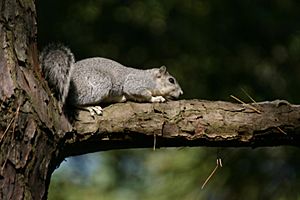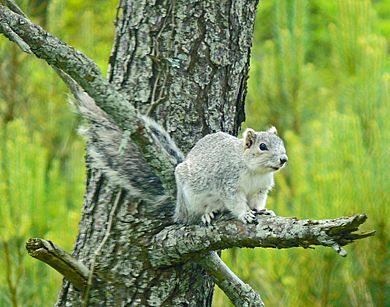Delmarva fox squirrel facts for kids
Quick facts for kids Delmarva fox squirrel |
|
|---|---|
 |
|
| Conservation status | |
| Scientific classification |
|
| Kingdom: | Animalia |
| Phylum: | Chordata |
| Class: | Mammalia |
| Order: | Rodentia |
| Family: | Sciuridae |
| Genus: | Sciurus |
| Species: | |
| Subspecies: |
S. n. cinereus
|
| Trinomial name | |
| Sciurus niger cinereus Linnaeus, 1758
|
|
The Delmarva fox squirrel (Sciurus niger cinereus) is a special type of fox squirrel. It used to be an endangered species, meaning it was at risk of disappearing forever. This squirrel lives in the eastern United States. Good news! In November 2015, it was taken off the endangered species list. This shows that conservation efforts can really help animals.
Meet the Delmarva Fox Squirrel
The Delmarva fox squirrel is a unique animal. It's a bit different from other squirrels you might see. Let's learn more about what makes it special.
What Does It Look Like?
This squirrel has a big, fluffy tail, just like other fox squirrels. Its fur is a frosty silver or slate gray color. It has a white belly. These squirrels can grow quite large. They can be up to 75 centimetres (30 in) (about 30 inches) long. This includes their tail, which can be 38 centimetres (15 in) (about 15 inches) long! They usually weigh around three pounds.
Where Do They Live?
Historically, these squirrels lived in many places. This included the Delmarva Peninsula, parts of Pennsylvania, and southern New Jersey. Today, you can mostly find them on the Eastern Shore of Maryland and Virginia. Their homes, called habitats, have changed over time. But thanks to people, they have been successfully brought back to other areas where they used to live.
What Do They Eat?
Delmarva fox squirrels love to eat nuts and seeds. They find these foods in mature forests. These forests have both hardwood trees and pine trees. They especially like eating from oak, hickory, sweet gum, walnut, and loblolly pine trees. In the fall, these trees drop their seeds, which is a feast for the squirrels. In summer and early fall, they also enjoy green pine cones. Sometimes, they eat other things too. These include buds, fruit, insects, and even grain.
Where Do They Sleep?
These squirrels prefer to make their homes, called dens, inside hollow trees. But if they can't find a hollow tree, they are clever. They will build a nest from leaves and twigs. They might build it in the fork of a tree branch. They can also build it in a tangle of vines on a tree trunk. Sometimes, they even build it near the end of a big branch.
When Are Baby Squirrels Born?
Delmarva fox squirrels usually mate in late winter and early spring. The mother squirrel carries her babies for about 44 days. Most young squirrels are born between February and April. A mother squirrel usually has 1 to 6 babies at a time. She raises them all by herself.
Saving the Delmarva Fox Squirrel

For many years, the number of Delmarva fox squirrels was dropping fast. Because of this, the U.S. Fish and Wildlife Service listed them as an endangered species in 1967. This meant they needed special protection.
Why Were They Endangered?
In 1967, only about 10% of their original population was left. There were two main reasons for this big drop.
- Overhunting: In the past, too many squirrels were hunted.
- Habitat Loss: Their homes were being destroyed. Forests were cut down for timber and to make space for farms. New houses, roads, and shops also took away their habitat.
Other animals also played a role. Predators like red and gray foxes, weasels, minks, and eagles hunt these squirrels.
How Were They Saved?
Many people worked hard to help the Delmarva fox squirrel. They tried to restore their habitats and increase their numbers.
Early Recovery Plans
In 1979, the first plan to help the squirrels was created. Biologists hoped to make the habitat better for the squirrels and other animals. This plan involved releasing squirrels into 11 different sites in Maryland. They released between 8 and 42 squirrels at each site over 1 to 3 years. They made sure to release an equal number of males and females. This helped them study how well the squirrels reproduced and survived.
Working Together for Habitat Restoration
Later, in the 1990s, more efforts were made. Both private and public lands were used to restore habitats. Most of the squirrel's historical range (about 87%) was on private land. Only 13% was public land. So, private landowners worked with biologists to help. They allowed experts to study and improve their land.
Moving Squirrels to New Homes
A key part of the recovery plan was moving squirrels. This is called translocation. Biologists would trap squirrels and move them to new, safe habitats. The main goals were to prevent extinction and increase the squirrel's numbers. They also wanted more areas to be involved in conservation. In one effort, 83 squirrels were moved. Each squirrel wore a radio collar. These collars helped biologists track their movements. This way, they could learn how far the squirrels traveled and where they went.
A Conservation Success Story
The effort to save the Delmarva fox squirrel has been a big success! The population has grown. The habitats are much better for them now. While many things threatened them in the past, continued work is important. This will ensure the Delmarva fox squirrel stays off the Endangered Species List.


